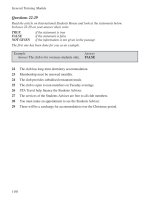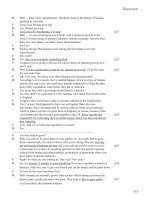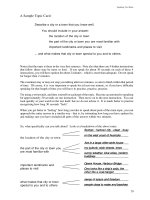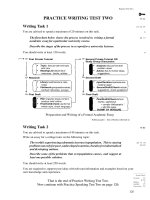101 helpful hints for ielts part 5
Bạn đang xem bản rút gọn của tài liệu. Xem và tải ngay bản đầy đủ của tài liệu tại đây (124.73 KB, 15 trang )
101 Helpful Hints for IELTS
WRITING TASK 2
UNDERSTAND WRITING TASK 2
Writing Task 2 is more important than Writing Task 1. Writing Task 2 counts more towards your
overall IELTS Writing Test Band Score than Writing Task 1. However, you must complete both
tasks to get an accurate Band Score. You are strongly advised to spend only 20 minutes on Writing
Task 1 before turning your attention to Writing Task 2. It is a mistake to spend longer than the advised
time on Task 1. You will definitely need 40 minutes on Writing Task 2, and you should leave some
time at the end of the hour to check your work in both tasks. (See Writing Hints 65 and 81.) Note
that you do not have to attempt Task 1 first. You can answer Task 2 first, if you wish.
The task requirement for Task 2 is that you write an essay or report of not less than 250 words on
a given topic of general interest. An essay is a literary composition on a particular subject. A report
is a formal account made after investigation of a subject, but for the purposes of the IELTS Writing
Test, a report can be written in the style appropriate for an essay. Therefore, in Task 2, an essay or
report can be either an argument regarding a topic, or an account of a situation regarding a topic.
This task assesses not only your ability to write, but also your ability to think about and discuss an
issue of some kind. It is, therefore, important that you have ideas and opinions on a wide range of
subjects of general interest, which means that you should be well-read and informed about most of
the popular and controversial issues that are debated in the media these days. Sometimes, the IELTS
Writing Task 2 topics are of educational interest, in which case your personal knowledge and
experience of the topic may be relevant, but be careful not to write about your personal experiences;
use them instead to talk generally and objectively about the topic. In addition, you will need to
present your thoughts in an organised and orderly way.
There are five steps in the process of writing an essay for the IELTS Writing Test:
STEP 1. ANALYSE THE QUESTION (approx. 1 minute)
The Writing Task 2 questions are of 2 basic types. In this book we will refer to them as Type A and
Type B questions.
Type A Questions
Firstly, there are questions requiring an argument as an answer. Essays that contain an argument
are those in which your opinions regarding a topic are essential, as is your understanding and
presentation of conflicting opinions. You should consider the argument as having two sides (usually
yes/no, or positive/negative), one of which you support.
If you reduce the argument to a yes/no question, the essay you write will be much like a debate in
which you present both sides of the issue: the side you believe in, and the side the opponents of your
views believe in. You should support your argument with sufficient evidence in order to prove your
point, as well as refute the opposing side of the argument. (See Writing Hint 80.)
64
Analyse the question
STEP I
Think about an answer
STEP 2
Plan the answer
STEP 3
Write the answer
STEP 4
Check the answer
STEP 5
Writing Test Hints
Type B Questions
Secondly, there are questions which require an account as an answer. Essays of this type ask you
to describe and explore the situation regarding the topic, with less emphasis on giving opinions. You
should describe the situation regarding the topic, and explore the reasons for the situation being what
it is. Although in this case you do not have to support an argument, it is wise to provide evidence
of the truth (or otherwise) of the situation.
In both Type A and B questions you may need to make recommendations, offer solutions, or give
advice.
• Look at the Task 2 questions for all four Writing Tests, and determine the question type,
Type A or Type B. Then check with the answers given below:
TEST Studying the English language in an English-speaking country is the best but not the
ONE only way to learn the language.
Do you agree or disagree with this statement?
TEST Describe some of the problems that overpopulation causes, and suggest at least one
TWO possible solution.
TEST Discuss the causes and some effects of widespread drug use by young people in modern
THREE
day society. Make any recommendations you feel are necessary to help fight youth drug
abuse.
TEST To what extent is nuclear technology a danger to life on Earth? What are the benefits and
FOUR
risks associated with its use?
Consideration of the Question
It will help when planning your answer to consider the Writing Task 2 questions as being written in
either wh/how, or yes/no question form. The latter is especially helpful when considering a Type A
(argument) question because it makes it easier to determine the opposing sides of the argument.
• Look at the Task 2 questions for Writing Tests One to Four below:
TEST ... becomes a yes/no question:
ONE
Studying the English language in an English-speaking country is the best, but is it the only
way to learn the language?
TEST ... becomes a wh question:
TWO
What problems does overpopulation cause? Can you suggest at least one possible solution?
TEST ... becomes two wh questions:
THREE
What are the causes and effects of widespread drug use by young people in modern day
society. What recommendations do you feel are necessary to help fight youth drug abuse?
TEST ... becomes a yes/no question (and the original wh question):
FOUR
Is nuclear technology a danger to life on Earth? What are the benefits and risks associated
with its use?
65
101 Helpful Hints for IELTS
STEP 2. THINK ABOUT AN ANSWER (approx. 2 minutes)
Before you can plan your answer, you need to think of 2 or more main ideas that you will use to
support what you have to say in your essay. This step is often referred to as "brainstorming". In
a true brainstorming session you write down as many ideas and words as you can that come into your
head as you think about the topic. Do not judge the worth of the ideas as they come to you - that comes
later, after you have put the notes you have made into groups of associated words and ideas.
This preparatory brainstorm session - alone, with a partner, or in a study discussion group - is
essential when writing essays at a tertiary level. It shows the complexity of the task, and reveals what
you already know and what you need to know about the topic in order to complete the essay.
Practise brainstorming well in advance of taking the IELTS test. See Speaking Hint 91 for Speaking
Test Stage 2 topics with which to practise brainstorming for ideas. Write down on a blank piece of
paper as many ideas and words as you can about the topic you choose. Next, put the topic in the
middle of an "Idea Web" like the one below, and put the words you have brainstormed into groups
of associated ideas. You do not have to include all the ideas that you write down.
• Look at the following brainstorming session used to create the model answer for Task 2 of
Writing Test One:
vs
proble4n&witfah*>ryte&ickne4i'
Uve/wi£h3ritiih/fci*yUly/pe<yple/
pronunciation-better
teachers - native/ ipeakery
culture/
home$tuy
listening- reading-
writing- speaking-
cut secondary school/ parents' help
learn/from/boohs- lea-Stressful/
advcLntugei-- money dedication/
Spoken/English- not good
High-School fUni/
Students- muust work/ hard-
Study and/living-costs-
grcwnmar - skM/ good/ for later
reasonable level of English
possible in home country if:
- student is gifted and
dedicated
do not have to worry about:
- accommodation costs
- study and living costs
- daily survival stress
HIGH SCHOOL /UNI
EDUCATION IN
HOME COUNTRY
STUDENT'S
SKILLS
TOPIC
Studying English in
an English-speaking
country: is it the
only way?
LESS STRESS IN
HOME COUNTRY
- spoken English not good
- grammar often advanced
- skill useful later overseas
ADVANTAGES OF
ENGLISH-SPEAKING
COUNTRY
IDEA WEB
- opportunities to practise with
English-speakers
- experience culture first-hand
- live with British family etc.
- attend a language school
- teachers are native speakers
Note that you do not have time in the actual test to complete a detailed brainstorming session or "Idea
Web" as illustrated above. The method is given for practice only. Nonetheless, you should regularly
brainstorm in order to develop the skills necessary to help you think of main ideas for your answer.
66
Writing Test Hints
With Type A questions, you will only write a successful essay if you can think of a minimum of 2
main supporting arguments for the case you wish to present. Similarly with Type B questions, you
will need a minimum of 2 main areas of discussion on which to base your essay about the topic. In
each case only 2 to 4 main ideas are necessary because of the length of the task - 250 words.
STEP 3. PLAN THE ANSWER (approx. 2 minutes) Q-w
You do not have time in the actual test to write a detailed plan like the sample plan shown below.
Your plan will need to be much shorter, and perhaps only "written" in your head. (Any written plans
in the actual IELTS test are ignored when your writing is assessed.) However, once you have thought
of the main ideas that your answer will contain, you do need to structure and organise your answer.
Evidence of organisational ability counts towards your Writing Task 2 Band Score.
You should only take a few minutes to read and understand the question, and to think of and construct
an answer (approximately 5 minutes for Steps 1 to 3). Therefore, it is important to know how to form
a well-organised plan quickly and skillfully with the ideas you have "brainstormed".
H Look at the plan for the model answer for Task 2 of Writing Test One:
PLAN (Test One)
TOPIC: Studying English in an English-speaking country
TYPE A QUESTION:
INTRO:
(approx. 40 words)
BODY:
PARAGRAPH 1:
(approx. 60 words)
PARAGRAPH 2:
(approx. 60 words)
PARAGRAPH 3:
(approx. 60 words)
CONCLUSION:
(approx. 30 words)
It is the best, but
(NO + REASONS)
(NO + REASONS)
(BEST WAY
+ REASONS)
(NO + REASONS)
250 words (minimum)
is (the topic) the only way?
= there are advantages of English study (in Britain?)
BUT my opinion -»NO, not the only way + REASONS
= students can learn English at high school (and university)
- grammar skills often advanced, but speaking poor
- good grammar will assist later (in Britain?)
= English study at home less stressful and fewer problems:
- with accommodation
- with study and living costs
- with daily survival in foreign country
= advantages of English study in Britain
- can practise listening to / speaking with native speakers
- can experience the culture (assists language study)
- should live with British family/people
- should attend language school with native speakers
= possible to reach good English level, if clever + work hard
Note these points about the plan above:
• The plan is composed of 5 parts: topic, question type, introduction, body and conclusion.
• The purpose of the introduction is to express the topic clearly. Also, since the task in this
case is to present an argument, the writer's opinion will be expressed in the introduction as well.
• There are 3 main ideas expressed in the body of the essay. The body consists of 3 paragraphs
containing 2 main ideas to support the writer's opinion, and 1 main idea to balance the
writer's opinion with the alternative viewpoint.
• The conclusion of the essay contains one minor point that is not fully developed, and a
viewpoint that is conditional.
• The total of the proposed minimum number of words for each paragraph is the minimum
number of words required to adequately complete the task.
67
101 Helpful Hints for EELTS
Complete the plans below for Task 2 of Writing Tests Two, Three and Four, by referring to the model
answers on pages 167, 168 and 169, and the example plan on page 67.
TOPIC:
TYPE
INTRO:
PARA.
B
0
PARA.
D
PARA.
CONC:
1:
2:
3:
Overpopulation
What problems does
(PROBLEMS:
CAUSES/EFFECTS)
(PROBLEMS:
CAUSES/EFFECTS)
(SOLUTIONS)
PLAN
(the topic) cause?
(Test Two)
Suggest at least one possible solution
TOPIC:
TYPE
INTRO:
PARA.
B
0
PARA.
D
PARA.
CONC:
1:
2:
3:
Widespread drug use by
What are the causes and
(CAUSES)
(CAUSES)
(EFFECTS)
PLAN (Test Three)
young people in modern day society
effects of (the topic)! Give recommendations to help fight it
TOPIC:
TYPE
INTRO:
PARA.
B
PARA.
D
Y
PARA.
CONC:
1:
2:
3:
PLAN (Test Four)
Nuclear technology
Is (the topic) a danger to life on Earth? What are the benefits and risks of using (the topic)?
(BENEFITS)
(BENEFITS)
(RISKS)
68
Writing Test Hints
STEP 4. WRITE THE ANSWER (approx. 30 minutes)
Once you have a plan, either quickly written down or in your head, the time comes to actually write
the answer. Begin with the introduction - there is no need to write a title, or repeat the question.
The Introduction
• Look at the introductions to the Task 2 model answers for Writing Tests One to Four:
TEST Studying a language in a country where it is widely spoken has many advantages. It is,
ONE therefore, a good idea to study English in a country such as Britain. However. I believe
it is not the only way to learn the language.
TEST In most countries of the world the population is increasing alarmingly. This is especially
TWO true in poor, undeveloped countries. Overpopulation causes a considerable number of
problems.
TEST Youth drug abuse is a serious problem nowadays in many cultures. Not only is illegal
THREE
drug use on the rise , but the children as young as ten years old are experimenting with alcohol
and tobacco. The reasons for this behaviour are unclear, but certain sociologists blame the
examples set by their elders.
TEST These days, many people are afraid of nuclear technology because of the dangers
FOUR
associated with its use. In my opinion, although it is true that nuclear weapons pose the
greatest threat to life, the use of nuclear technology for peaceful purposes also carries some
serious risks.
The topic sentence of each introduction (shown in bold print) states the main idea of the paragraph,
and introduces the theme of the essay itself. The ideas within the paragraphs are joined together with
connective or linking words (shown underlined). In all these examples, the topic sentence is the first
sentence of each paragraph. It does not always need to be the first sentence, but it makes the
paragraph easier to write. (See also Reading Hint 42.) Notice how the topic sentences are clear,
simple, interesting and informative. (See also Writing Hint 62.)
Tests One and Four are answers to Type A questions (argument essays). Note that the writer's
opinion is given in the introduction.
In all introductions the sentences following the topic sentence give the reader an idea of how the rest
of the essay is constructed. They function similarly to a "map" of the essay, although, as in the
examples above, the map need not be complete in a short IELTS essay. (See also Writing Hint 68.)
The final sentence of the introduction leads naturally into the first body paragraph
The Body
• Look at the first body paragraphs of the Task 2 model answers for Writing Tests One to Four:
TEST In the first place, most students in non-English-speaking countries learn English at
ONE secondary school, and sometimes at university nowadays. Although their spoken English
is not usually of a very high standard, their knowledge of grammar is often quite advanced.
This is certainly useful when students come to an English-speaking country to perfect the
language.
TEST In poor countries it is difficult to provide enough food to feed even the present number
of people. In addition, education to limit the number of children per family is not always
successful. Poorer countries usually have a lot of unemployment too, and an increase in
population simply makes the situation worse. The environment also suffers when there are
too many people living on the land.
69









